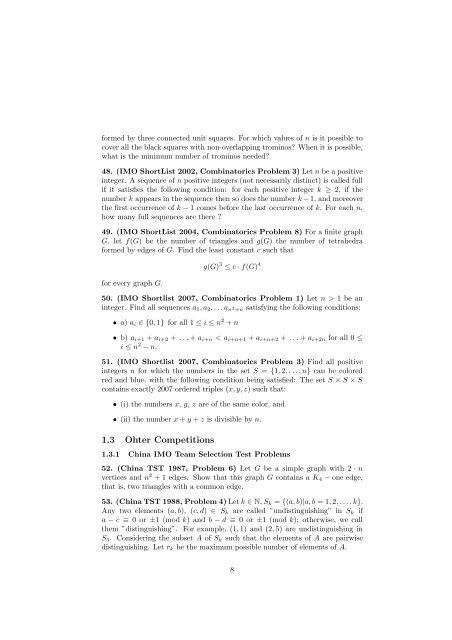Combinatorics Problems
Combinatorics Problems
Combinatorics Problems
You also want an ePaper? Increase the reach of your titles
YUMPU automatically turns print PDFs into web optimized ePapers that Google loves.
formed by three connected unit squares. For which values of n is it possible to<br />
cover all the black squares with non-overlapping trominos? When it is possible,<br />
what is the minimum number of trominos needed?<br />
48. (IMO ShortList 2002, <strong>Combinatorics</strong> Problem 3) Let n be a positive<br />
integer. A sequence of n positive integers (not necessarily distinct) is called full<br />
if it satisfies the following condition: for each positive integer k ≥ 2, if the<br />
number k appears in the sequence then so does the number k −1, and moreover<br />
the first occurrence of k − 1 comes before the last occurrence of k. For each n,<br />
how many full sequences are there ?<br />
49. (IMO ShortList 2004, <strong>Combinatorics</strong> Problem 8) For a finite graph<br />
G, let f(G) be the number of triangles and g(G) the number of tetrahedra<br />
formed by edges of G. Find the least constant c such that<br />
for every graph G.<br />
g(G) 3 ≤ c · f(G) 4<br />
50. (IMO Shortlist 2007, <strong>Combinatorics</strong> Problem 1) Let n > 1 be an<br />
integer. Find all sequences a 1 , a 2 , . . . a n 2 +n satisfying the following conditions:<br />
• a) a i ∈ {0, 1} for all 1 ≤ i ≤ n 2 + n<br />
• b) a i+1 + a i+2 + . . . + a i+n < a i+n+1 + a i+n+2 + . . . + a i+2n for all 0 ≤<br />
i ≤ n 2 − n.<br />
51. (IMO Shortlist 2007, <strong>Combinatorics</strong> Problem 3) Find all positive<br />
integers n for which the numbers in the set S = {1, 2, . . ., n} can be colored<br />
red and blue, with the following condition being satisfied: The set S × S × S<br />
contains exactly 2007 ordered triples (x, y, z) such that:<br />
• (i) the numbers x, y, z are of the same color, and<br />
• (ii) the number x + y + z is divisible by n.<br />
1.3 Ohter Competitions<br />
1.3.1 China IMO Team Selection Test <strong>Problems</strong><br />
52. (China TST 1987, Problem 6) Let G be a simple graph with 2 · n<br />
vertices and n 2 + 1 edges. Show that this graph G contains a K 4 − one edge,<br />
that is, two triangles with a common edge.<br />
53. (China TST 1988, Problem 4) Let k ∈ N, S k = {(a, b)|a, b = 1, 2, . . .,k}.<br />
Any two elements (a, b), (c, d) ∈ S k are called ”undistinguishing” in S k if<br />
a − c ≡ 0 or ±1 (mod k) and b − d ≡ 0 or ±1 (mod k); otherwise, we call<br />
them ”distinguishing”. For example, (1, 1) and (2, 5) are undistinguishing in<br />
S 5 . Considering the subset A of S k such that the elements of A are pairwise<br />
distinguishing. Let r k be the maximum possible number of elements of A.<br />
8
















